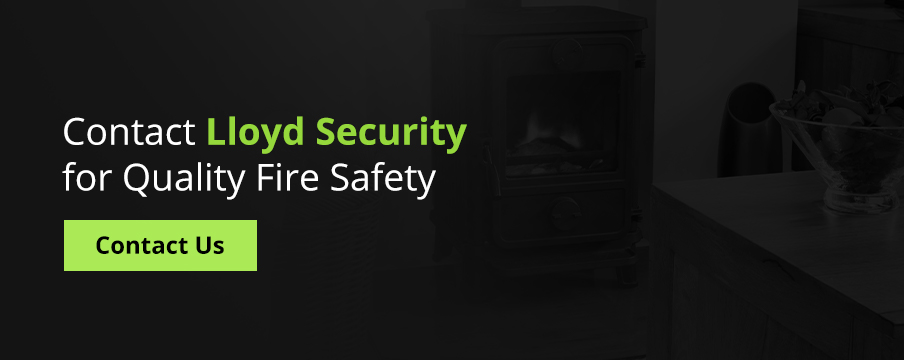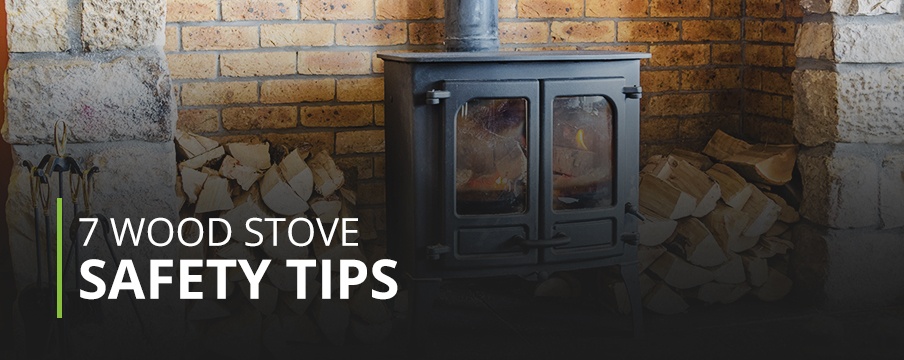JUMP TO:
1. Keep up With Preventive Maintenance and Operations
A wood-burning stove or fireplace can be a delightful addition to your home. It can give you and your family a warm, homey feeling — both literally and figuratively — and can enhance your home’s décor. However, having exposed flame in your home presents risks. It’s vital to have a thorough understanding of wood-burning stove heating safety to prevent any fire mishaps. Let’s look at some safety tips for burning wood in stoves and fireplaces.
1. Keep up With Preventive Maintenance and Operations
It’s smart to call in a qualified professional every year to check your stove or fireplace and chimney. An annual wood-burning stove safety check will ensure everything is in working order. A professional can also check if any parts need replacement and discuss maintenance and general fireplace safety tips you can perform more often.
One of the best safety tips for a fireplace or stove is to clean it thoroughly after burning wood. Fires create ash, soot and creosote, which pose fire hazards. Creosote is a substance that can condense against the walls of your stovepipe or chimney. It can take the form of sticky, runny liquid, black flakes or hardened tar, which will be challenging to clean off. The majority of home heating equipment fires arise out of creosote buildup in the chimney.
Ash buildup can also present a hazard, reducing airflow and producing a smokier fire. Ash can also trap heat, making a fire harder to extinguish.
You can clean much of your stovepipe and chimney with a wire brush. Regularly clean the ashes out of your fireplace, and treat them as hot embers that could start a fire. Keep ashes in a covered metal bucket, and let them sit for three days before disposing of them.
2. Use the Right Fuel
The only thing you should be burning in your wood-burning stove or fireplace is wood. The safest fuel is seasoned hardwood that has been split, cut and air-dried for over a year. This wood provides the best, cleanest burn. Green, soft or wet woods will produce too much smoke, which can fill up your house and cause air quality problems. They can also accelerate creosote buildup.
It’s never safe to throw trash or anything other than wood into a wood-burning stove or fireplace. Paper and cardboard products can create a taller flame that’s harder to control. Other products like rubber and plastic may release harmful toxins as they burn. It’s also unsafe to use lighter fluid or gasoline to start a fire. Even coal can be dangerous unless you have a multifuel stove with a grate.
3. Observe Chimney Safety
Your chimney has a crucial role to play in wood stove and wood-burning fireplace safety. It vents smoke up and out of your home, keeping your air fresh and irritant-free. It’s critical to practice good chimney safety and keep it clean.
Chimney fires can be an invisible danger. These slow-burning fires don’t get enough oxygen to produce visible flames, so they often go undetected. You may not even know you’ve had a chimney fire until your next inspection. However, even when they don’t escalate into a house fire, you can severely damage your chimney. If you have a prefabricated metal chimney, you must have it replaced after a chimney fire. A masonry chimney could sustain cracks, making it liable to collapse. These conditions may cause the fire to spread to the rest of your house.
If you have a wood-burning stove, you need to use the correct type of chimney. It must be either a prefabricated, Underwriters Laboratory-listed metal chimney or a lined masonry chimney. Many older chimneys are only a single layer of brick and may not contain a liner. Make sure your chimney uses at least two layers of brick, and have it surveyed to check that it’s safe and intact. If your chimney doesn’t have a liner, have a UL-listed metal liner installed. Do not connect your stove to the same flue that vents an oil burner, as it could become a conduit for toxic oil vapors into your home.
It’s a good idea to have any fireplace or wood stove chimney inspected before starting your first fire. Like the stove or fireplace itself, the chimney should have an annual inspection and cleaning. Meanwhile, a chimney cap will keep out rain, moisture and small animals.

4. Use Safe Ventilation
Your venting system is separate from the chimney. Wood-burning stoves feature a stovepipe for ventilation. Safe stovepipes are as short as possible and feature no more than two right-angled elbows. If possible, house your stovepipe inside your prefabricated or masonry chimney. Keep it at least 18 inches away from all combustibles.
To practice good fireplace safety, make sure to use the damper properly. The damper controls airflow to the fire. When it’s open, it allows smoke to billow up the chimney rather than into your living room. Open the damper before starting a fire, and close it after the fire extinguishes.
5. Keep Fire Extinguishers at the Ready
Fire extinguishers should be near the stove, easily seen and accessible to everyone. Class A fire extinguishers are portable and efficient on most household combustibles, including wood, paper and textiles.
All family members should learn how to use them. To help, the National Fire Protection Association offers simple operation instructions. Just remember the acronym PASS. First, pull the pin, pointing the nozzle away from yourself. Aim low, slowly squeeze the lever, then sweep the from side to side. Also, make sure kids do not play with the fire extinguisher.
6. Contain Your Fire
Everyone loves the fire’s soothing crackle. While these sounds add atmosphere, they can also be a danger. When an ember goes flying, it could land on something combustible, like your couch. Whether you have a stove or a fireplace, it should come with doors. Fireplaces and some stoves also have a mesh screen. Use either the screen or the glass doors to contain your sparks and embers. Stacking your logs far back in the fireplace stops them from rolling or falling out. Only use a nonflammable, heat-resistant carpet near your hearth.
7. Install Fire Alarms and Other Safety Indicators
According to the National Fire Protection Association, 41% of residential fires occur in houses that lack smoke alarms. Another 16% involve homes with an inoperable smoke alarm. Functional fire, smoke and carbon monoxide alarms are crucial for fireplace and wood-burning stove safety. Make sure to install them and test them regularly. Keep a fire or smoke alarm in all bedrooms, and one on each level of the house.
It’s also a smart idea to install a smoke alarm and carbon monoxide detector near your fireplace or wood-burning stove. If your wood-burning fireplace or stove is venting smoke or harmful chemicals into your home, you’ll pick up on it right away. Test your smoke alarms once a month, and change the batteries before they die out.
Today’s modern residential fire alarms offer interconnectivity, which means if one goes off, they all will. This added layer of protection ensures you hear the alarm even if you’re not near the fire. This technology is especially essential with wood-burning stoves, which may be heating your home throughout the night.
An integrated alarm and security system also lets you monitor your fire, smoke and carbon monoxide detectors from your phone. You’ll receive instant alerts if any alarm goes off. You’ll also get notified when a device needs new batteries. This alert can be lifesaving, since 25% of smoke alarm failures stem from dead batteries. Plus, through Lloyd Security, you can access remote monitoring for your home security and fire alarms. We’ll be your eyes and ears when you’re not home for ultimate fire protection.

Contact Lloyd Security for Quality Fire Safety
In addition to our wide range of home security solutions, Lloyd Security also has state-of-the-art fire and smoke alarms to quickly alert your family and enhance burning wood safety. We can install your smoke, fire and carbon monoxide alarms as part of a complete home automation system for comfort, convenience and safety. Our alarms give you the early warning you need when a fire is at risk of becoming out of control. To learn more, call Lloyd Security at 612-874-9295 or contact us online today.

